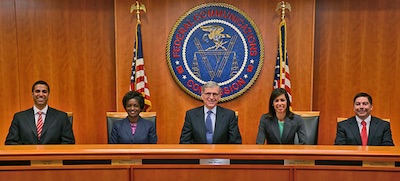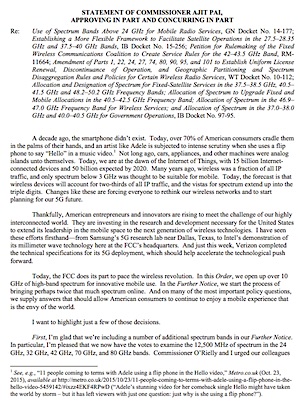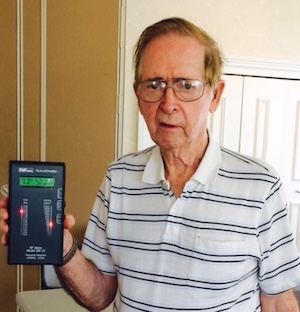 |
 |
The five FCC commissioners each made statements on the new technology. Health and environmental considerations are absent from them. Tom Wheeler is chair and commissioners are Mignon Clyburn, Jessica Rosenworcel, Ajit Pai and Michael O’Rielly.
Rosenworcel has been called “an outspoken advocate for families and students unable to access the internet after school hours for homework.”
She has supported the “Digital Learning Equity Act” now before the House of Representatives and is an outspoken proponent of “pushing forward on 5G.” She has never been quoted saying that caution must be used by children with cellphones and computers.
Rosenworcel spoke at the “Wi-Fi Now” conference in Tysons Corner, Va., April 19-21. O’Dwyer reporters were banned after saying they would raise health concerns about Wi-Fi.
Ellie Marks, chair of the California Brain Tumor Assn., cites scientific evidence of damage done by radiation and has compiled a list of more than 300 notables who died of brain cancer, many of them in their 40's, 50's and 60's.
Her plea to the FCC this week and the pleas of many other healthcare advocates that 5G be tested before rollout were ignored.
We have found the same obstinacy in our hometown of Westhampton Beach, Long Island.
Peak Radiation Where WH Board Meets
Our Acoustimeter shows a peak of six volts per square meter in the very room where the library board holds monthly meetings. When we showed that to trustees at their meetings, all we got was derision and laughter. Microwatts of pulsed radiation per square meter are in the 1,000 to 2,500 range in the room.Bioinitiative.org says there is no safe level of pulsed radiation over long periods of time.
|
|
Comments from board members include the view that the sun emits radiation so why don’t we worry about that and Wi-Fi is “everywhere anyway” and is even brought into the library by people with their cellphones. Yes, and the library should be warning patrons not to press the phones to their ears or carry them in their pockets.
Board members, headed by Tom Moore, husband of Westhampton Beach Maria Moore, are not budging on our request to see any of the routers that are in the ceilings of the library on both floors that are causing the radiation.
They have directed us to supplier Cablevision where VP-Communications Lisa Anselmo of parent Altice will not come to the phone or answer our emails.
WH Children Were Radiated July 13
Our plan was to hold up the Acoustimeter in the boardroom July 13 but, for the first time in memory, the board switched to the second floor children’s area for its meeting. A program for children took over the first floor meeting room. Instead of six volts per square meter, the second floor only shows two to three volts, which is still unsafe. Microwatts per square meter are in the 1,000-2,500 range.
|
|
The indicated course of action would be for the library to retain healthydwellings.com or a similar service and do a room-by-room census of the radiation.
Children, babies, fetuses and regular patrons are victims but the biggest victims are staffers who are subjected to the rays 7-8 hours a day, five days a week. Staffers at the Library of Paris led in banishing Wi-Fi from the library in 2008.
Westhampton Beach’s board of trustees also turns down our requests to see the routers that are causing dangerous levels of radiation in Village Hall. They won’t provide any of the specs and reject Freedom of Information filings.
Reactions to FCC Start Coming in
Wi-Fi health advocates have just begun to cope with the new FCC policies.
Advocate Ed Friedman says that 5G uses millimeter frequencies of the spectrum that penetrate minimally and this means millions of transceivers will be needed to move data any distance.
“Minimal penetration,” he adds, “means skin and eyes are the main tissues affected immediately, where all of the wave energy is concentrated and the points from which the disruption of cellular communication chains to deeper areas of the body will begin.”
Millimeter waves will also disproportionately affect small creatures like insect pollinators with high energy versus a longer wave were most of the energy would not be trapped in the body but pass through it.
Kit Weaver of SkyVision Solutions noted that the objections of several Commissioners were basically that the FC lacks the expertise to deal with cybersecurity and should leave this to the [non FCC] “experts.” It was also noted that not enough bandwidth was being made available.
“There was not a word about safety although they got excited about various potential uses of the new bandwidths and really excited that the US will be first despite apparent objections from the pesky International Telecommunications Union,” she said.
Landlines Under Attack
The second part of the session was to approve measures that will make it easier for carriers to get rid of landlines. Commissioner O’Rielly said one important goal is to remove obstacles to consumer choice. Health advocates say the public is losing its choice to keep safe, reliable, secure and acoustically excellent landlines.
Health advocates say there is again no concern with safety. Here is the FCC release:
WASHINGTON, July 14, 2016 – Landline phone network technology is changing rapidly, and today, the Federal Communications Commission further updated its rules to help ensure that consumers, industry and the economy reap the benefits of this ongoing, innovative transformation.
Today’s action will eliminate outdated, unnecessary regulations and establish clear criteria that can expedite the review process required when providers update service from legacy to modern voice technologies.
The new framework will give carriers the clarity they need to transition quickly to innovative services and at the same time ensure continued protections for consumers, competition, public safety and universal service, all important values that must endure even as technology changes.
Voice service providers are transitioning from legacy network technology – known as time-division multiplexing or TDM – to service using internet protocol (IP) technology and wireless. The FCC has authority under Section 214 of the Communications Act to protect consumers when service is discontinued, but a review processes without clear standards could needlessly slow beneficial technology transitions.
Under the new rules, a company’s application to discontinue legacy TDM-based voice service in a technology transition can be automatically granted in 30 days if the applicant meets a clear, objective, three-pronged test. This test recognizes that while many consumers have welcomed new services, legacy technologies remain relevant for others.




 Lo Isidro, senior director at Real Chemistry with more than a decade of strategic communications and PA experience, has joined Narrative Strategies.
Lo Isidro, senior director at Real Chemistry with more than a decade of strategic communications and PA experience, has joined Narrative Strategies. Nelson Fernandez, former North American chair of APCO Worldwide and managing director of Burson-Marsteller, has joined Volunteers in Medicine Berkshires as director of communications and PA.
Nelson Fernandez, former North American chair of APCO Worldwide and managing director of Burson-Marsteller, has joined Volunteers in Medicine Berkshires as director of communications and PA. Lilit Bargar, who was most recently an EVP in the healthcare practice at Weber Shandwick, comes on board at GCI Health as EVP, corporate practice lead.
Lilit Bargar, who was most recently an EVP in the healthcare practice at Weber Shandwick, comes on board at GCI Health as EVP, corporate practice lead.
 Five ways that successful thought leaders are made.
Five ways that successful thought leaders are made.


 Have a comment? Send it to
Have a comment? Send it to 
No comments have been submitted for this story yet.